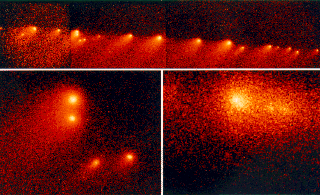
Comet Shoemaker-Levy 9, torn into pieces as a result of a close approach to Jupiter in July 1992, will collide with Jupiter during the third week of July 1994. Of tremendous scientific importance, the impacts of the cometary fragments will release more energy into Jupiter's atmosphere than that of the world's combined nuclear arsenals. Because the impacts will occur on the night side of Jupiter, the explosions will not be directly observable from Earth. However, professional and amateur astronomers may observe the impact light flashes reflected off the inner satellites of Jupiter. Any lasting effects on Jupiter, such as atmospheric clouds, ejecta plumes, or seismic thermal disturbances, may be observable an hour or so later when the rotation of Jupiter brings the impact sites into Earth's view.
Analysis of high-resolution images of the comet taken by the NASA's Hubble Space Telescope in July 1993 suggests that the major cometary fragments range in size from one to a few kilometers. The large fragments are embedded in a cloud of debris with material ranging in size from boulder-sized to microscopic particles. Although comet-like outgassing of the fragments has not been observed, the fragile nature of the object suggests that it is indeed a comet rather than a more compact asteroid.
Comet Shoemaker-Levy 9 was the ninth short-periodic comet discovered by Eugene and Carolyn Shoemaker and David Levy. It was first detected on a photograph taken on the night of March 24, 1993 with the 0.4-meter Schmidt telescope on Palomar Mountain in California. Subsequent observations were forthcoming from observers at the University of Hawaii, the Spacewatch telescope on Kitt Peak in Arizona and McDonald Observatory in Texas. These observations were used to demonstrate that the comet was in orbit about Jupiter, and had made a very close approach (within 1.4 Jupiter radii from Jupiter's center) on July 7, 1992. During this close approach, the unequal Jupiter gravitational attractions on the comet's near and far sides broke apart the fragile object. The disruption of a comet into multiple fragments is an unusual event, the capture of a comet into an orbit about Jupiter is even more unusual, and the collision of a large comet with a planet is an extraordinary, millennial event.
